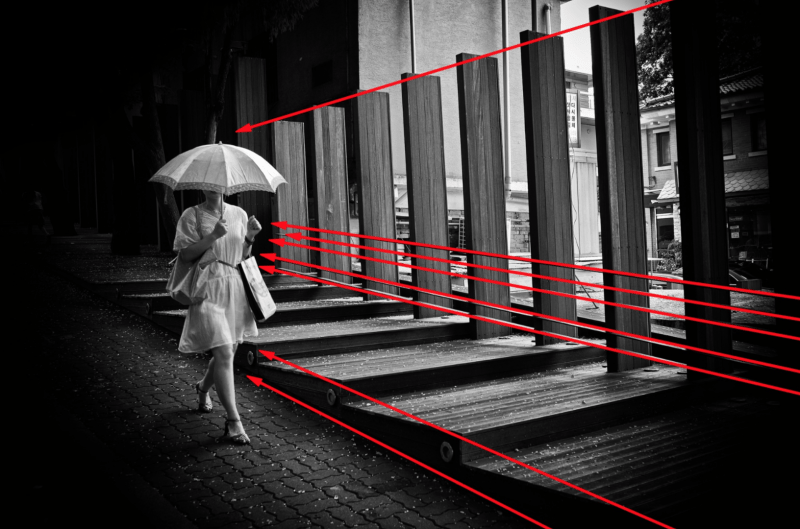Your cart is currently empty!
The Street Photography Composition Manual

Dear streettogs, you might have read it in my last update post from Paris, but I am excited to release my newest free (and “open source“) e-book: “The Street Photography Composition Manual.” The book is a distillation of all the lessons I have learned about composition and street photography, and I put it into a handy PDF which you can print out, carry around on your iPad, or read it from the convenience of your laptop.
Download
Book Description

“Geometry is the language of man… he has discovered rhythms, rhythms apparent to the eye and clear in the relations with one an- other. And these rhythms are at the very root of human activities. They resound in man by an organic inevitability, the same fine inevi- tability which causes the tracing out of the Golden Section by chil- dren, old men, savages, and the learned.”
– Le Corbusier (1931, Towards A New Architecture)
Are you a street photographer and want to learn how to use your intuition to capture better “decisive moments” on the street? Do you feel frustrated that your photos tend to be cluttered, uninteresting, and lack emotion and magic?
This book will teach you the fundamentals of composition in street photography: the importance of diagonals for dynamic images, strong contrast to separate your subjects from the background via “figure-to-ground,” how to juxtapose your subjects, color theory, and how to create compelling stories.
“Composition must be one of our constant preoccupations, but at the moment of shooting it can stem only from our intuition, for we are out to capture the fugitive moment, and all the interrelationships involved are on the move.”
– Henri Cartier-Bresson
This book will also provide you with contact sheets and a behind-the-scenes look to some of my most iconic images, and how you can create similar images.

Furthermore, you will learn how changing your perspective will totally transform your images. A subtle change to your approach will make all the difference in your images:
“The photographer’s eye is perpetually evaluating. A photographer can bring coincidence of line simply by moving his head a fraction of a millimeter. He can modify perspectives by a slight bending of the knees. By placing the camera closer to or farther from the subject, he draws a detail– and it can be subordinated, or he can be tyrannized by it.”
– Henri Cartier-Bresson
This book is a distillation of all the lessons I have learned about street photography and composition over the years. I dispel some of the myths of “the decisive moment,” how you can often see composition after-the-fact, and the secret for making memorable street photographs.
This is a unique book and no other resource exists quite like it. Consider it your practical one-stop guide and manual for improving your composition in street photography. Furthermore, it is open and free for you to download, print, share, distribute, translate, remix, to help support the community of street photography.
I have written this out of pure love, and I hope you enjoy reading it as much as I enjoyed putting it together.
Love,
Eric Kim
@ Aix-en-Provence, France / July 1, 2015
Table of Contents

Below is the overview of all the chapters and sections in the book:
- Introduction to Composition in Street Photography
- The “Fishing Technique”
- Leading Lines
- Perspective & Leading Lines
- Seeing Leading Lines After-the-Fact
- Chapter 1: Dynamic Street Photography
- Hand Gestures
- Repeating Hand Gestures
- Not Showing Faces
- Chapter 2: Horizontal vs Vertical Framing
- When to Shoot Horizontals vs Verticals?
- Horizontal Shots
- Vertical Shots
- Shooting Both Horizontals and Verticals
- When to Shoot Horizontals vs Verticals?
- Chapter 3: Triangles
- The Golden Triangle: Introduction
- Applying the Golden Triangle
- Applying Composition After?
- The Golden Triangle Overlay in Lightroom
- Working the Scene
- To Crop or Not to Crop?
- Triangles in 3 Subjects
- Contact Sheets
- Contact Sheet: Mumbai, 2013
- Contact Sheet: SF, 2015
- Composition & Intuition
- The Golden Triangle: Introduction
- Chapter 4: Figure-to-Ground
- Look at the Background First
- The “Figure-to-Ground Test”
- How to Create Your Own “Figure-to-Ground Test”
- Example of “Poor” Figure-to-Ground
- Dramatic Light & Figure-to-Ground
- Flash & Figure-to-Ground
- Chapter 5: Juxtaposition
- Juxtaposing Emotions
- Juxtaposing Directions
- Surrealist Juxtaposition
- Chapter 6: Color Theory
- Red-Green Complementary Colors
- Orange-Blue Complementary Colors
- Contact Sheet: SF, 2015
- Violet-Yellow Complementary Colors
- Warm vs Cool Colors
- Warm Colors
- Contact Sheet: Tucson, 2013
- Contact Sheet: Downtown LA, 2013
- Cool Colors
- Cool Colors with a Splash of Warm
- “Is it Street Photography?”
- Warm Colors
- Chapter 7: Storytelling
- Open vs Closed Photos
- Open-Ended Emotion
- Eye Contact?
- Closed Photos
- Storytelling Without People?
- Can You Create a Truly “Objective” Photograph?
- Chapter 8: Conclusion
- Emotions are King
- Break the Rules
- Give Back
Sample pages from the book







